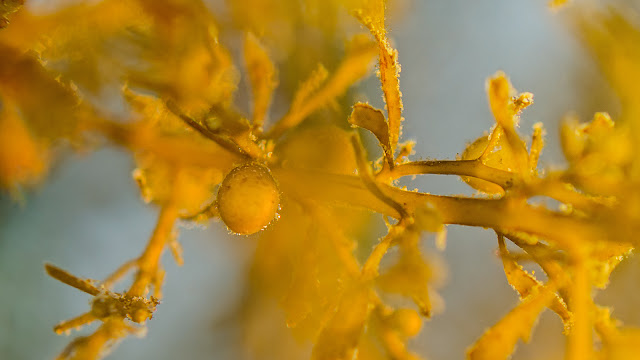 |
| Wireweed (Sargassum muticum), in the "empty" end of the tank. |
Sargassum muticum is usually 1-3 m in length, but can grow up to an incredible 16 m in length in certain habitats, and can form floating mats on the sea surface. It can grow at up to 10 cm each day, and it also has a relatively long life-span of 3-4 years. ... Dense mats of Sargassum can form very quickly. (The Seaweed Site)
The branch I removed this evening was 12 cm. long. I'm beginning to see why the total amount in the tank remains the same.
 |
| Section of today's crop, showing bladders, reproductive structures, and a few leaf fragments. |
Sargassum muticum is an invasive seaweed, originally from Japan. It has spread enthusiastically to the west coasts of both Europe and North America; on this coast, its range goes from Mexico to Alaska. Besides its fast growth habit, it is also extremely good at starting new plants.
 |
| Branch tips with reproductive vesicles. They look like miniature cucumbers. The bumps show that they're mature and ready to spread "germlings". |
A branch doesn't have to be attached to the parent to reproduce itself. It can float free for months, still growing, still fattening up these "cucumbers". The infant plants ...
... develop into small germlings and develop adhesive rhizoids (rootlike structures), at which point the offspring will release from the parent plant and sink to the bottom; where they will adhere to whatever substrate they land on. (Sargassum muticum)
I've been noticing a lot of new, brown growth on the glass of the aquarium. I wipe it off every couple of days; I've never had to do that before. Are those new baby wireweed plants?
Broken branches float to the surface. They are buoyed up by dozens of small bladders full of air. In the wild, they float away from the parent plant, seeding new territory as they go.
 |
| Gas bladder. Leaves and reproductive vesicles in the background. |
 |
| Another gas bladder. These get up to about 3 mm across. |
Nicholson et al. (1981) reported on a possible short-distance dispersal mechanism they called "walking Sargassum," in which entire plants attached to fist-sized rocks drift with the currents and sink to the bottom where the water slows. (Exotics Guide)
Wireweed has created problems where it has taken over territory, cutting off light to eelgrass and other plants, fouling shores, pushing out native species. Attempts at removing it, (up to 480 tons in three years in southern England: it was back again the next year) have been unsuccessful. In my tank, I can rip it out, scrub the walls, replace the stones, and maybe get rid of it. Maybe.
But I've noticed, with other invasive species, like the Asian mud snails, how after a few years, the natives begin to fight back, and eventually come to a new balance. Nature does love variety and resists monoculture. It will be interesting to watch how it works out in our waters.
And my hermits are beginning to find it interesting; at any time, day or night, three or four are clambering through the upper levels. They do love a climb!
(On the branch above, the longest leaf I found was 6 mm. long, the bladders were up to 3mm., and the "cucumbers" are up to 4mm. long, about 1mm wide.)

Interesting information and perfect shots to tell the tale. - Margy
ReplyDelete